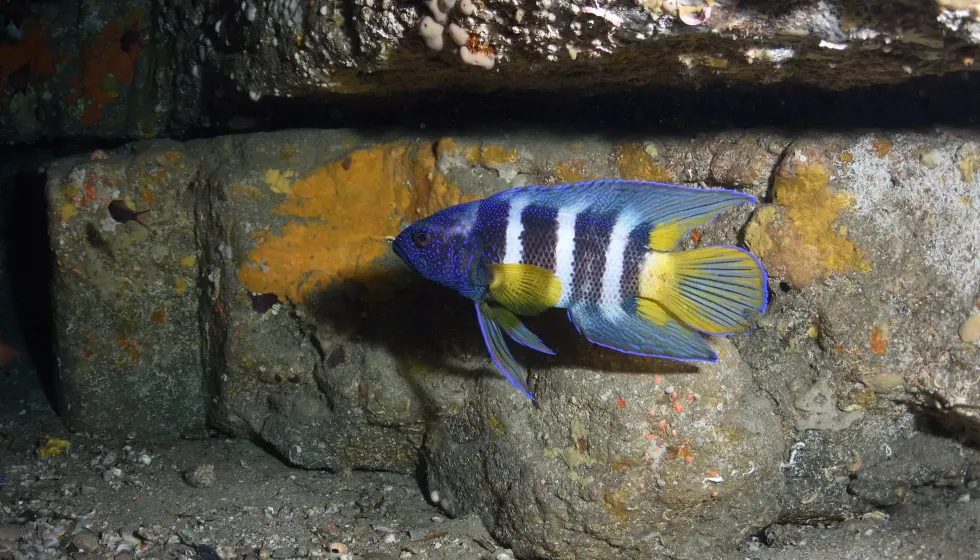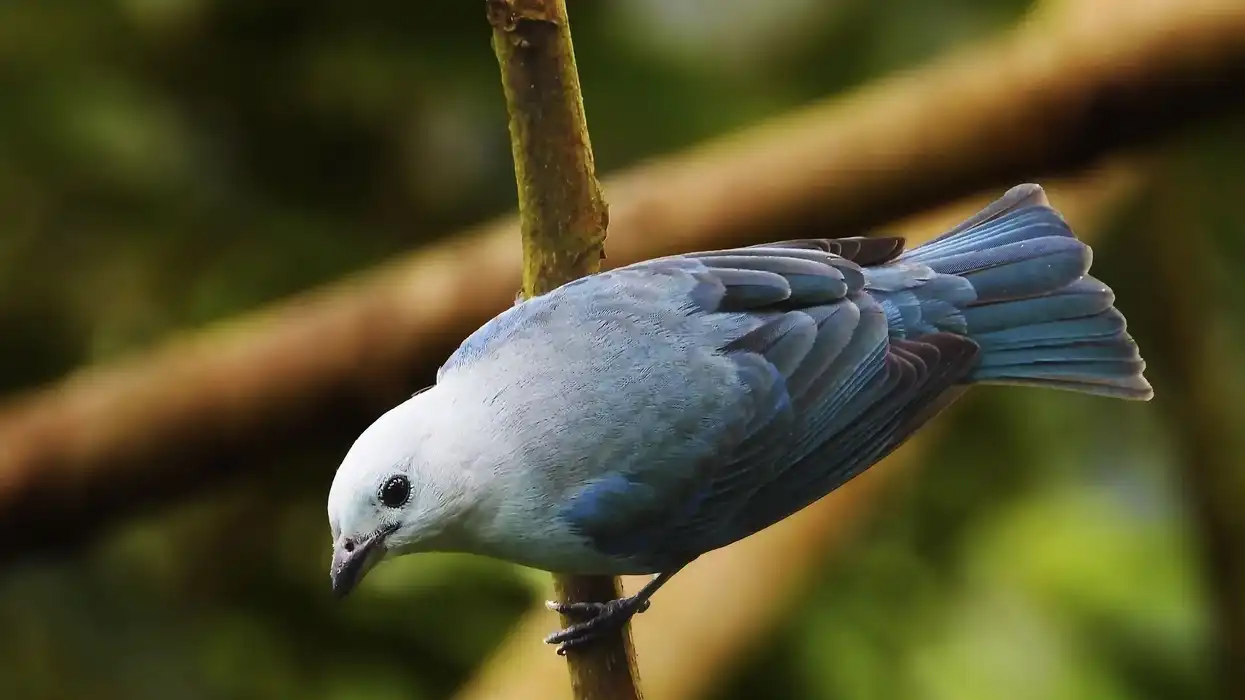The blue devil fish species belongs to the family Plesiopidae. Blue devil paraplesiops genus of fish is found in stone reefs and coral reefs close to Australian coastlines.
According to the location of their habitat in Eastern Australia, Western Australia, and Southern Australia, blue devil paraplesiops are named eastern blue devil fish, western blue Devil fish, and southern blue devil fish. Blue devil means low spirits or despondency. 'Gould's Book Of Fish' features a blue devil fish.
Often mistaken as a part of the blue devil paraplesiops genus, the Fiji blue devil damsel fish (Chrysiptera cyanea) belongs to the genus Chrysiptera. The Fiji blue devil damsel is also known by other names like the southseas devil damselfish, and village belle.
It shares a similar blue coloration as the blue devil fish species found close to the Australian waters.
To understand blue devil fish facts properly, it is required to take a closer look at all three varieties of Australian blue devil fish. The southern blue devil fish usually live in underwater caves. They are found along the coastline of Southern Australia.
This fish species has dark blue or brown coloration with bright blue spots. The anal and pelvic fins are quite large.
The western blue devil fish is also called ‘blue devilfish’. These fish prefer a solitary life and are also cave dwellers. The eastern blue devil fish, also known as Bleeker’s blue devil fish, live in reefs and estuaries close to the coasts.
You may also check out the fact files on drum fish and sawfish from Kidadl.
Blue Devil Fish Interesting Facts
What type of animal is a blue devil fish?
Blue devil fish are marine fish or saltwater fish inhabiting the oceans around Australia. They are found close to the coastline in underwater reefs.
What class of animal does a blue devil fish belong to?
Blue devil fish belongs to the Actinopterygii class. These saltwater fish are usually shy and live in underwater caves, crevices of reefs around Australian coasts. These striking blue sea fish or saltwater fish are extremely popular with divers and photographers. Their striking blue coloration makes them easily recognizable. They are mostly found close to their homes.
How many blue devil fish are there in the world?
It is difficult to pinpoint the number of blue devil fishes in the Australian oceans and marine aquariums. Some species receive protection while some don’t.
Where does a blue devil fish live?
All blue devil fish species live in oceans. They are also kept in saltwater aquariums. Southern blue devils or the paraplesiops meleagris are common in Southern Australian reefs.
They are mostly cave-dwellers living in hiding places that are more than five meters deep to forty meters underwater. These fishes live in colonies that may be inhabited by several juveniles and adults. This species can be seen along the coast from southern and eastern Victoria to Houtman Abrolhos Islands in Western Australia.
What is a blue devil fish's habitat?
The western blue devil fish mostly stays in their homes in the rocky reefs, coral reefs, underwater caves, and crevices. These fish are highly territorial and live a solitary life. Males protect their territory from other males of the same species. They can be seen in their habitat at the depth of 196.8-1772 in (5-45 m).
The eastern blue devil fish (Paraplesiops bleekeri) has similar preferences and lives in reefs and estuaries, hiding in caves and crevices. These fish are shy and prefer not to be seen.
They often take refuge under ledges of inshore estuaries and coral reefs. This fish species can be found in shallow waters as well as in the depth of up to 1181 in (30 m).
The range of eastern blue devil fish stretches from southern Queensland to NSW’s south coast. This blue devil species is a protected fish in NSW under the Fisheries Management Act 1994.
People may land up paying heavy fines if they are caught carrying eastern blue devil fish or possessing them at home. This species is known to live a solitary life and is most active during the night.
Who do blue devil fish live with?
All blue devil fish generally live in breeding pairs. They are highly associated with their particular habitat and do not like to explore new waters. They like caves, reefs, and deep rocky overhang as home.
How long does a blue devil fish live?
Blue devil fish have a long lifespan. The southern blue devil fish can live up to sixty-five years in their natural habitat.
The blue devil damsel fish is often mistaken as an Australian blue devil variety. They are found in the sheltered bays, lagoons of the Pacific Ocean, edges of the Indian Ocean, Indonesia, Philippines, Palau, and the Solomon Islands. These blue fish can live up to six years in their wild habitat and for around fifteen years in captivity.
How do they reproduce?
All blue devil Paraplesiops genus fish lay eggs onto the substrate. Usually, males guard the eggs until they hatch. Breeding season for yellow-blue, rare, eastern blue devil fish or paraplesiops bleekeri stretches from October to March.
These fishes lay eggs in groups in close locations. The eggs remain glued to the underside of caves and ledges where they live until fries are hatches.
The newborn fish look like larvae. These freely swimming tiny young fish are just 0.15 in (4 mm) long. These fish settle down close to the reef areas when they attain a length of about 0.39 in (10 mm).
What is their conservation status?
The conservation status of the blue devil fish species is Not Evaluated. However, some of these species receive local protection. The eastern blue devil fish enjoys protection in their natural habitat in waters around NSW.
They are highly protected due to rarity and low availability. The main threat to these fish is trade for saltwater aquariums and collections. The southern blue devil species or the paraplesiops meleagris does not enjoy protection in their wild habitat.
Blue Devil Fish Fun Facts
What do blue devil fish look like?
Various blue devil fishes have a stunning look with bright blue spots, white-blue bands, and yellow fins. The western blue devil fish and the southern blue devil fish look extremely close to each other.
It is difficult to tell one species from the other, except for the fact that their range differs. Eastern blue devils are close relative to the other two species but have a different appearance.
The southern blue devil fish and the western blue devil fish have unique iridescent blue spots on their body. The base color of the body is dark blue or brown. There is a pale blue margin running to the long dorsal, anal, and pelvic fins.
The long anal and dorsal fins have earned the fish the name of longfin. These fishes are also known by the name spiny basslet.
Just like a tiger's unique stripes, adult blue devil fish have unique blue markings on the lower part of the gill cover. Marine scientists, use those distinguished markings to identify individual fish when monitoring them.
The eastern blue devil fish looks different than the other two varieties. These fish have a blue and white banded pattern on the body. The head has blue spots.
These fish have blue dorsal and anal fins, while the tail fin is bright yellow with blue markings. The pelvic fins and the dorsal and anal fins are elongated like their close cousins. These fishes can grow up to about 15-16 in (38-41 cm) in length.
The young fish are less colorful with a dusky brown body and with less visible stripes. Their coloration becomes vivid as they grow in age.
Males have ventral fins and yellow or orange tails while females have transparent fins and mostly blue tails.

We've been unable to source an image of a Blue Devil Fish and have used an image of its habitat. If you are able to provide us with a royalty-free image of a Blue Devil Fish, we would be happy to credit you. Please contact us at hello@kidadl.com.
How cute are they?
Blue devil fish are generally shy marine fish. They are marine wildlife and cannot be called cute. These fishes are beautiful to look at with their bright coloration.
How do they communicate?
Blue devil fishes are marine creatures living in reefs close to the Australian coastline. This species of fish are shy and like to live in their home grounds. Males can be territorial and guard the eggs with the females before they are hatched.
How big is a blue devil fish?
An eastern blue devil can grow up to sixteen inches long. That is more than three times smaller than a mahi mahi fish that grows up to 50-55 in (127-140 cm).
How fast can a blue devil fish swim?
The blue devil fish are not extremely fast swimmers and they like to remain in their caves most of the time.
How much does a blue devil fish weigh?
The maximum recorded weight of the southern blue devil fish is 2.49 lb (1.12 kg).
What are the male and female names of the species?
There are no special names given to the male and female blue devil fishes.
What would you call a baby blue devil fish?
A baby blue devil fish at birth is called a larva till its yolk sac is attached to its body. In the next stage, the young fish is called a fry.
What do they eat?
Blue devil fishes usually feed at night. These fish are often called ‘generalist carnivores’ as they also eat other bony fish and all kinds of small benthic crustaceans. Benthic crustaceans are organisms like shrimps, crabs, copepods that live on the surface of the sea or the ocean. Their diet mostly includes small crustaceans, mollusks, small fish, gastropods.
Are they eaten by humans?
Blue devil fishes are not included in the human diet. Sometimes these fishes are kept in marine aquariums.
Would they make a good pet?
No, blue devil fish are marine wildlife and do not make good pets.
Did you know...
The possession of the protected eastern blue devil fish is considered a crime in NSW (New South Wales). For breaking these rules the monetary fine can go up to $11 000 along with a jail term of three months.
Are blue devil fish territorial?
Blue devils are mostly territorial, especially the males. When setting up a marine aquarium to house blue devil fishes, they have to be given enough space that they can claim.
The western blue devil does not prefer a reef-style aquarium, but corals and anemones in the tank. Its main diet includes shrimp and small fish. It is better to keep these fish alone or in a male and female pair in a very large aquarium designed with a lot of live rock from the ocean.
What are some other names for blue devil fish?
There are many names for the Australian blue devil fish. According to their species, they are called blue-tipped longfin, Bleeker's blue devil fish, blue devilfish. The Fiji blue devil damsel fish are also known as southseas devil, southseas demoiselle, sapphire devil, Fiji damsel, and the sky-blue devil.
Here at Kidadl, we have carefully created lots of interesting family-friendly animal facts for everyone to discover! For more relatable content, check out these cuttlefish facts and clownfish facts for kids.
You can even occupy yourself at home by coloring in one of our free printable blue devil fish coloring pages.










